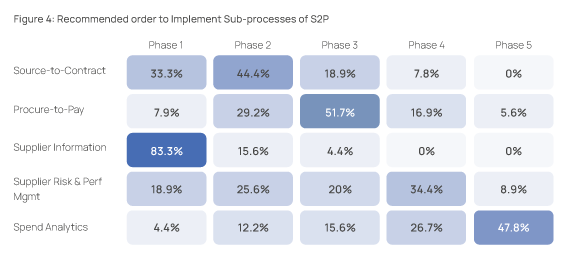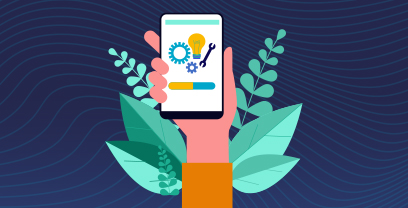Implementing procurement technology to automate and enhance your S2P processes is a critical step in driving efficiency and value across your operations, but it’s an exercise fraught with potential challenges. From scope creep and budget overruns to resistance to change, the pitfalls of poor planning can derail even the most strategic plans.
In this article, we draw on insights from seasoned experts who have overseen countless Source-to-Pay (S2P) projects across industries. In a recent Procurement Implementation Survey collecting almost 100 survey responses across 31 system integrators, who implement procurement solutions daily, they shared key strategies and best practices to ensure your technology implementation delivers measurable success and maximizes return on investment.
Phases of Procurement Technology Implementation
S2P technology can transform your procurement teams and processes! Most of the implementation experts we asked to share advice underlined that executive buy-in is absolutely vital for success. Therefore, ensure that you have strong executive sponsorship and clearly defined project goals and objectives before starting your transformation project.
Analyzing all your procurement processes before implementation helps align technology capabilities with organizational needs. After choosing the right procurement solution, implementation then typically unfolds across several phases.
The timeline depends on factors such as your organization’s complexity, the solutions and capabilities being deployed, the extent of required integrations and the potential need for configuration..
Source-To-Pay Technology Implementation Timeline
No matter the scope of your new procurement technology, make sure that you don’t neglect any of the different implementation phases:
- Preparation Phase: This phase involves detailed planning, defining success metrics, engaging stakeholders, assessing data readiness, and forming the implementation team.
According to our survey, this phase should include “understanding current procurement challenges and [your] existing procurement landscape with clear and concise objectives and goals to achieve with the S2P implementation.
[Organizations] must consider the scope of the system, various modules, implementation sequence, data flow[s] and integration requirements, reporting and analytics capabilities, level of customization(s) needed and establish a thorough change management plan before implementation begins.”
- Design Phase: This implementation phase focusses on process mapping, solution configuration based on business requirements, and alignment on process improvements and automation.
- Build Phase: During the build phase, system configurations are finalized, integrations are developed and implemented, and data migration efforts begin.
- Testing Phase: Rigorous testing, including user acceptance testing (UAT), ensures any gaps or issues are identified and resolved before the new procurement solution goes live. Key stakeholders validate the system during this phase.
- Go-Live and Rollout: While phasing out the legacy system, the new procurement technology is deployed for end-users and supplier onboarding can begin. To minimize risks and ensure a smooth adoption, many organizations implement a phased rollout strategy, beginning with a pilot group to test and refine the process before full-scale implementation.
- Post-Implementation Support and Optimization (Ongoing): This stage focuses on training users, monitoring system performance, resolving issues, and refining the solution based on feedback and evolving business needs.
A Step-by-Step Approach to Procurement Transformation
Ivalua’s recent survey revealed that experts often recommend implementing procurement technology in steps rather than the whole S2P process at once. 83.3% of respondents indicated that Supplier Information Management is prioritized by many organizations as the first step for full Source-to-Pay implementation. The following figure outlines the recommended order to implement sub-processes of S2P as per our survey respondents:
Figure 1: Recommended order to Implement Sub-processes of S2P

Most common Challenges of Implementing Procurement Technology
Whether you are implementing a full-scope procurement solution or sub-processes (e.g., Source-to-Contract, Supplier Management, Procure-to-Pay, Contract management, etc), there are plenty of challenges and pitfalls that you should be aware of to avoid delaying or jeopardizing your procurement transformation project.
According to our solution partners, these are the most common ones:
- Stakeholder Alignment and Change Management: Resistance to change and misalignment across departments can significantly impede the adoption process, resulting in project delays, or even incomplete implementation, ultimately limiting the solution’s potential benefits.
Procurement experts further warned to avoid “assigning inadequate resources to the implementation project. One of the most common reasons for failure is the belief that the customer’s project team can manage such initiatives while being allocated, for example, only 20%-30% of their time in addition to their regular duties.”
“The effort required to implement procurement technology is nearly the same for both, the implementation partner and the customer, especially when it comes to global companies with complex procurement processes and many stakeholders involved, who might have no prior experience in IT projects.”
- Scope Changes or Expansion: Changes or expansion in scope are a common implementation challenge but also the number one reason for going over budget. Clear boundaries and well-documented project requirements are crucial to prevent scope changes that lead to increased costs and extended timelines.
- Data: Data migration and integration issues during implementation can include poor data quality, inconsistencies, and the complexity of syncing with existing ERP systems. Effective integration capabilities are critical to navigating these hurdles successfully and ensuring a smooth process.
- Configuration vs. Customization: While the capability to configure a solution to your particular business is critical, you need to decide how much to configure and whether complex, time-consuming and potentially costly configurations are indeed necessary versus nice to have. Customizations are something you should try to avoid completely, especially as some platforms are designed to be more configurable and adaptable than others through no-code / low-code configuration.
- Budget: As for any impactful long-term project sticking to the original allocated budget can be challenging. Our implementation experts have experienced this time and again for reasons including most often: scope expansion, complex configuration requirements, data and integration challenges, unanticipated organizational changes, not enough staff that’s been allocated to the project and so on.
To avoid going too much over budget, ensure that you set a realistic project budget and then stick as much as possible to the initial project plan and scope.
Tips & Tricks for Successful S2P Technology Implementation
Implementing comprehensive procurement technology can feel daunting, but with the right approach, it’s an opportunity for transformation and lasting results. Our surveyed implementation partners shared invaluable advice to make implementation and transitioning from legacy systems fluid and more successful.
One of the ways to smooth out the path and set your teams up for success, suggested one of our implementation partners in the survey is to “Speak to an expert before you start your journey, they will be able to steer you away from many of the pitfalls and give you a realistic sense of what it takes to be successful. A little bit of time and money invested upfront will prevent headaches and cost overruns in the implementation.”
Additionally, they can “offer strategic insight into optimizing your procurement processes. This will ensure that your investment in S2P technology maximises the positive impact on your business.”
Strong Change Management Focus & Clear Communication
Effective change management is critical for a successful procurement technology rollout. Strategies like early stakeholder involvement, clear communication of benefits, and appointing change champions can foster engagement and ensure smoother adoption.
Selecting an internal project manager to coordinate efforts and act as a liaison between the vendor or implementation partner and the organization further streamlines the process. Prioritizing user engagement builds buy-in and helps to ensure the new system is adopted effectively, maximizing its value from the outset.
Avoid too much Customization
Customization adds complexity, therefore potentially time, cost and risk. Adopting out-of-the-box functionalities and standard processes helps maintain system integrity and simplifies maintenance. If you do need bespoke tools, choose a solution that allows customization through configuration—ideally leveraging no-code or low-code capabilities so you can adapt certain elements independently.
Pilot Go-live First, Broader Rollout Later
As mentioned above, breaking up the whole procurement implementation into steps can help better organize full roll-out. Additionally, our experts advise to begin with a pilot go-live to evaluate the system’s performance with a smaller user base. This approach allows you to use lessons learned during the pilot to refine and optimize the broader rollout, which reduces disruptions and boosts user confidence.
Plan for Integration and Data Migration
Ensuring that data is clean and integration points are clearly defined at the outset is crucial to avoiding issues later in the implementation project. Make sure that your new procurement technology can integrate seamlessly with existing enterprise systems, such as ERPs or finance systems. Data readiness is a significant factor for a smooth transition to the S2P platform.
Provide Comprehensive Training and Support
Effective user adoption hinges on role-specific training programs and accessible support resources. Customized training sessions tailored to each user’s responsibilities, paired with tools like digital adoption platforms, e-learning modules, and on-demand resources, ensure users feel confident and supported throughout the transition. By providing continuous guidance and fostering a user-centric approach, organizations can maximize the value of their procurement technology and drive long-term success.
Download the complete S2P Implementation Guide and Survey Results here.
Success Story: How implementing Procurement Technology future-proofed FCL’s S2P Processes
Federated Cooperatives Limited (FCL) is a large, member-owned cooperative based in Canada, serving various industries, including agriculture, energy, food, and home and building supplies. One of the key factors of success to achieve comprehensive procurement transformation was their focus on stakeholders and user experience, said Tanya Roach, Director of Procurement.
FCL leveraged Ivalua’s user-friendly sourcing and supplier management modules to drive high adoption rates and improve efficiency. By enabling better management of sourcing events and increasing spend under management, Ivalua’ solution has significantly streamlined FCL’s processes. Throughout implementation and scaling, Ivalua has proven to be as a responsive and reliable partner, particularly when it came to new use cases and AI-driven solutions, explained Ms. Roach.
Read the full Federated Cooperatives Limited (FCL) case study.
Conclusion
In conclusion “Don’t approach it as a simple system implementation. Consider it a real transformation” was certainly the most spot-on advice we collected in our survey!
Source-to-Pay (S2P) technology can deliver significant advantages, including streamlined workflows, enhanced visibility across all categories of spend, and data-driven decision-making powered by advanced analytics. It strengthens supplier relationships through improved collaboration and ensures better compliance with organizational and regulatory standards, driving both efficiency and accountability.
However, its impact depends on how well the end users – procurement teams and suppliers – adapt to the new processes. To make it an easy and better experience for end users, invest in comprehensive training, clear communication, and ensure ongoing support from the vendor side to ensure that users and suppliers understand the value of the system and use it proficiently..
If preparation, implementation, training and onboarding are done right, S2P technology has the power to transform procurement.




